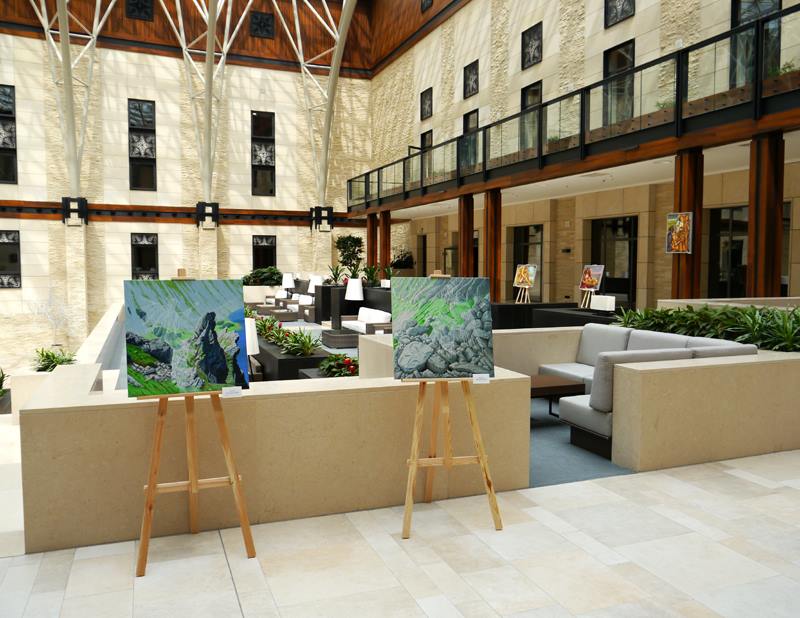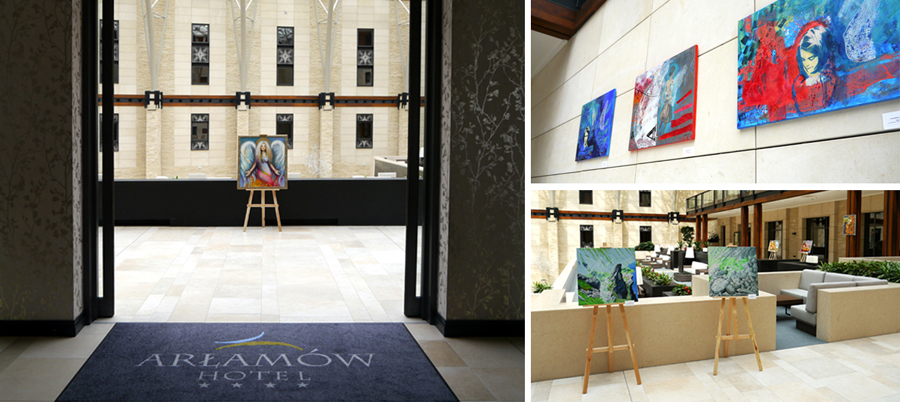
At the beginning of 2014, the delightful patio of the ARŁAMÓW Hotel **** was additionally decorated with angelic paintings from the collective exhibition of the PositiveArtLive.com artists entitled "Where Angels Live".
The five artists presented their artworks: Anna Masiul-Gozdecka, Jolanta Hałas, Halina Kaźmierczak, Anna Rosiek and Joanna Tokarczyk
The Greek word ángelos (angel) means messenger.
Since ancient times, people believed in invisible beings who mediate between the spiritual world and people. In our culture, the figure of an angel has its origins in Greek and Roman antiquity and Judaism. In the Bible, we find references to creatures created by God, which in their appearance refer to representations known from the art of the Middle East, but it was the Greek, winged Nike and Roman Victoria (goddesses of victory) that influenced the formation of the angelic canon in European art. According to Ambrose of Milan, the six-winged seraphs occupy the highest position in the angelic hierarchy. It's the first choir, surpassing all others with love, therefore they are closest to God and contemplate Him. The meaning of the wings of angels is explained by John Chrysostom: “They manifest the exalted nature of angels, therefore Gabriel is depicted with wings. This doesn't mean that they actually possess them, but they are an attribute of angelic power and have no meaning other than to indicate the sublime of their nature."

In addition to their supernatural significance, wings denote the speed of movement, allowing angels to quickly appear on earth with a divine message. Christian art made the figures of God's messengers with full impetus entered the arena of sculpture and painting. Until about the 4th century, angels didn't have wings, they were ordinary men and only thanks to the subject of the work could it be recognized that it was an angel. The earliest image of "men of God" with wings comes from "The Prince's Sarcophagus" - a children's tomb discovered in the 1930s in Sarigüzel near Istanbul. Since then, angels in European iconography have received wings for good. Four- and six-winged angels usually have only a face and wings. These creatures illustrate the power and might of God. The two-winged ones, on the other hand, are ascribed to the earthly reality: they are His messengers and protectors of man. We know divine beings sparkling with gold and precious stones from Byzantine mosaics. Dignified and sublime, with a halo of heads and expressionless faces devoid of any emotion, they have little in common with the later, protective guardian. Rather, they arouse respect and devotion, faithfully surrounding Christ and Mary, and guard the heavenly reality. This "Greek manner" persisted until the times of Giotto, who made a revolution in the art of European painting in line with the Copernican revolution in astronomy. From that moment, angels take on an increasingly human, down-to-earth appearance. The scenes of the Annunciation of the Blessed Virgin Mary became a popular "angelic" theme in late medieval art. The angel descends to earth and is no longer a formidable guardian of God's presence, but God's messenger and servant of man. The Renaissance and the Baroque made another revolution: putti appear - naked, plump children with wings, completely stripped of supernatural dignity, but this isn't accidental: along with directing people's minds to ancient roots, they refer to the winged Cupid - the Roman god love. Baroque for a short while tried to rehabilitate them again by adding to the Marian theme. And that was the end of the apogee of the angels, which with the advent of the Age of Enlightenment, like all religious art, lost their importance. They have already gained a completely new, secular quality: they have become popular "cupids" striking people's hearts with an arrow of love. They survived in folk and sepulchral art and as spiritual guardians of each of us. The latter role is mainly associated with the pictures we know from childhood: an angel carrying two children across a leaky bridge. - Joanna Czernik-Zemanek
Hotel **** ARŁAMÓW offers a beautiful view of the mountains, forests and valleys from each room of this delightfully designed and constructed place.


